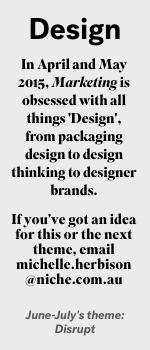Five ways mobility is changing how designers work
Share
Unshackled from legacy technology, designers are increasingly empowered in mobility and collaboration, writes Paul Burnett, Paul Burnett, Adobe APAC evangelist.
 Designers are being released from the confines of the desktop and, more importantly, from the confines of the office, to go out and seek inspiration from the world around them. Mobility, made possible by technological advances and, in particular, the arrival of the cloud era, is providing designers with access to a whole new palette from which to work, seamlessly.
Designers are being released from the confines of the desktop and, more importantly, from the confines of the office, to go out and seek inspiration from the world around them. Mobility, made possible by technological advances and, in particular, the arrival of the cloud era, is providing designers with access to a whole new palette from which to work, seamlessly.
How designers utilise technology to fuel their creativity and evolve their designs will push the creative sector to new heights. There are five trends that have real potential to influence the future of design – and there are clear signs these trends are already starting to have an impact on cutting edge design.
 1. The paper napkin has become digital
1. The paper napkin has become digital
Designers want to do professional design no matter where they are. Traditionally, they have been restricted to the desktop or laptop in the office. The change that we’re seeing now is the ability to break free of the desk and the office and continue to work – outdoors or on the move, where creativity and inspiration actually occurs most. That is the future, with designers moving away from the office and its constraints and being able to work at a professional level on mobile devices. No matter where they are, be it in a coffee shop or a park, on their phone or tablet, they are able to start doing work that
is not just for play, but accessing real and powerful solutions that let them tap into the environment around them.
We’re already starting to see paper napkin designs go digital. Russell Brown, known by many as the father of Photoshop, left his DSLR (digital single lens reflex) camera at home while on a recent trip to Asia, opting to do all of his creative and design work on his phone and tablet and a GoPro, in surroundings that he found inspiring. It really enabled him to break free, to be mobile and be creative.
2. Collaborative workflows are becoming seamless
We’re responding to the need for creatives who want to be able to capture content whenever they want and, through the cloud, have access to that content wherever they are, and to provide seamless access to others – community, colleagues, clients and vendors.
This is where we see another shackle of creativity being broken. With the cloud, a new era of collaboration has begun. Designers have always been collaborative. Now the cloud allows them to extend that natural working style to wherever people are. Once work was shared in a linear fashion, and people worked on designs one person at a time. In the cloud, whole groups can work together, at the same time and in real time – they can collaborate at any time and don’t need to be sitting next to each other. It is a technology change that is going to continue to open up and create more freedom for the way that designers work together.
That ability to collaborate is now even more important. Once, if you were a designer you were simply working on a magazine, say; but today, if you’re working on a magazine, that means you’re probably also designing for a digital magazine, a website, social media and potentially video. Your scope has had to broaden dramatically. So all of the people working across those different areas can now work together on the same content with the same ideas simultaneously – no matter where they are.
3. The design process is beginning to start with mobile
Any discussion about the future has technology close to its heart, but we are now at a stage where so many of the devices, platforms and tools we are working with today did not even exist as little as five years ago.Five years ago we were introduced to the first iPad. Amazingly, tablets are now increasingly central to both creation and consumption. And again, design is central to that.
The mobility that first came with tablets is being seen in the shift to mobile. It was not so long ago when design and development were first and foremost dedicated to the desktop experience. Then they shifted to tablet and mobile. Now, it is mobile first. Anything in the future of design will have mobile and tablet as the first thought before anything else.
4. Consumer tech is taking design to new heights
Designers are only just beginning to understand the profound effect consumer technology – such as 3D printing – can have on designers and marketers. Take packaging as a prime example. Where once I would design my prototype and wait weeks for it to arrive to see if my vision worked in reality, now I can conceive, design and print my vision in a matter of hours. With the aid of a 3D printer, I can see if it works and how it can add to the experience of the consumer, because packaging is so much a part of how we begin our relationship with the products we come to love.
Such advances are being joined by other ‘consumer- first’ technologies that will be limited only by the imaginations of designers. Wearable devices are directly affecting our interaction with the world around us and drones are changing our perspective of the world. These popular devices will play a pivotal role in how designers work. Again, imagination will be the only limitation.
5. Design is getting personal
In Adobe’s New Creatives research last year, three- quarters of creatives said technology has changed creativity more in the last five years than it had in the last 50 – and that can be quite overwhelming. If you are a designer now, you are not doing the things you were doing five years ago. Now, keeping up with technology is taking up a larger percentage of your time. Cutting edge technology is now no longer the stuff you would catch up with when you had a moment. Instead, it’s imperative to keep up-to-date and refresh your skills and understanding on a very regular basis.
Which brings us to whom design is ultimately aimed at and where the future of design lies. It is no longer all about design for a broad, mass demographic, but design for the individual. Above all else, design will be driven by personalisation. With the help of digital marketing tools, when you create a design now it can really be targeted at so many different audiences with diverse needs and expectations. Where once the broad brush of marketing was enough to deliver the message, now it needs to reflect each person and deliver an experience unique to them and how they are living and what inspires them.
In my view, this is the greatest opportunity for designers going forward. To engage at the most personal level with each member of the audience, making their experience unique and compelling.
Adobe is a Marketing content partner – a non-financial collaboration on content for the magazine and exclusive benefits for Marketing Advantage Members. Click here for more information.















